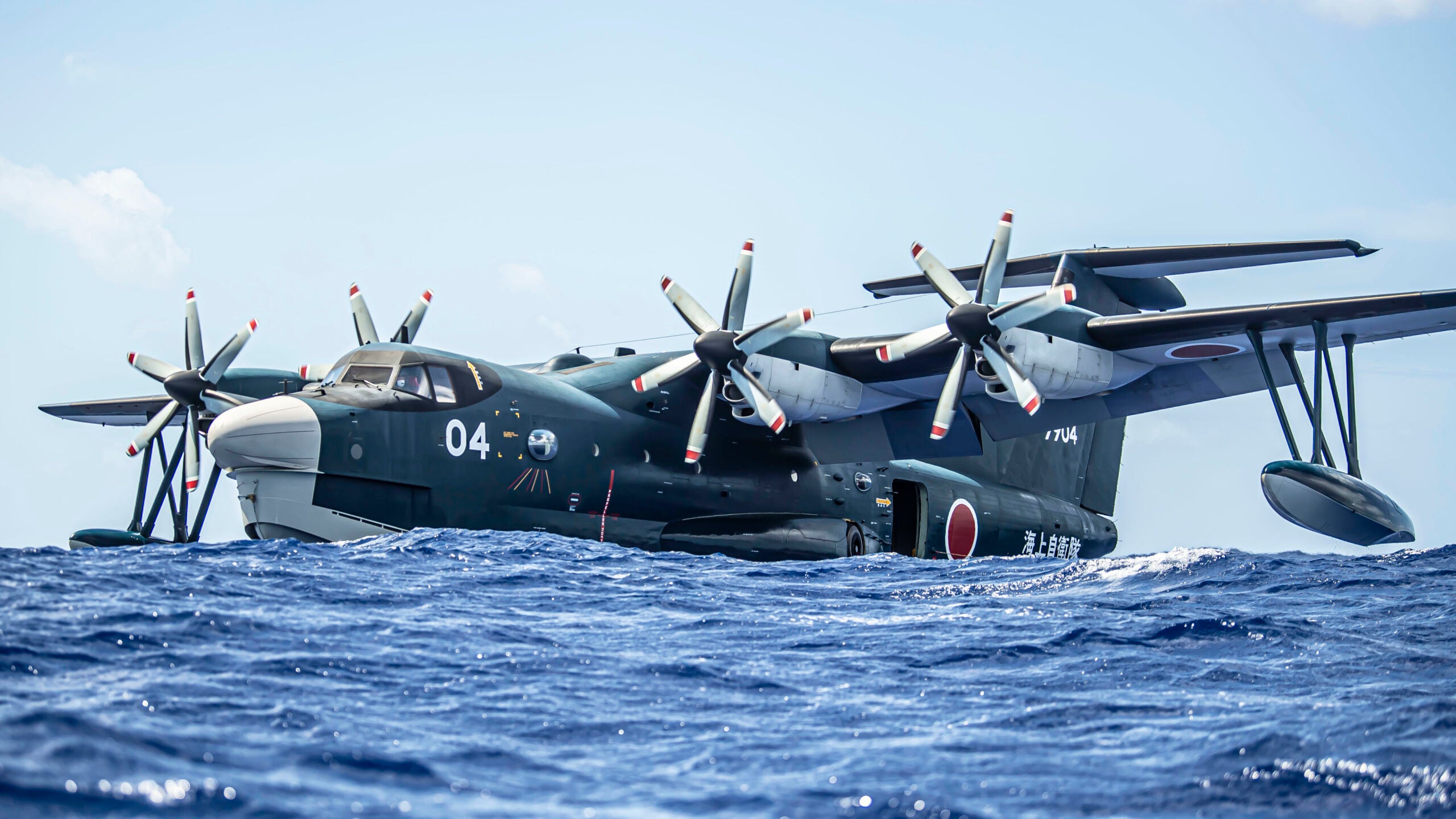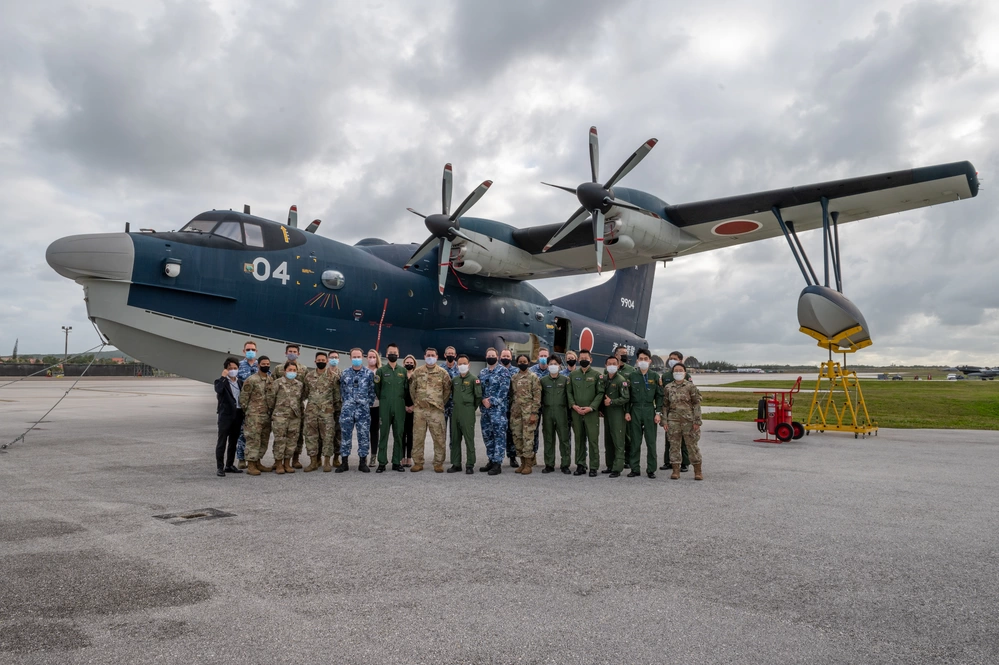In the contemporary era, only a handful of nations possess the expertise to conceptualize and construct seaplanes, and Japan proudly stands among them. Presently, the Japan Maritime Self-Defense Force relies on the ShinMaywa US-2 multi-role seaplanes, a fleet comprised of six of these remarkable aircraft. The acquisition of the sixth seaplane in 2013 came with a hefty price tag of 12 billion yen, translating to nearly $156 million, solidifying the US-2’s status as the world’s most expensive seaplane.

Situated just behind the sleek nose, the cockpit of the ShinMaywa US-2 offers unparalleled visibility forward, flanked by engines on either side. Enhancing the pilot’s command interface, the glass cockpit boasts an integrated control panel where a single LCD panel seamlessly merges digitalized meters.
The cutting-edge design of the ShinMaywa US-2 incorporates a fly-by-wire flight control system, elevating the aircraft’s safety and controllability through computerized precision. Beneath each main wing, pontoons are strategically positioned to assist the plane in maintaining balance on water. Weighing in at 25.6 tons when empty, the aircraft’s maximum takeoff weight reaches an impressive 47.7 tons.
Versatility is a hallmark of the ShinMaywa US-2, with the capacity to accommodate up to 20 passengers or 12 stretchers. The tricycle-type landing gear facilitates operations on land, adding to the aircraft’s adaptability.
Powering the ShinMaywa US-2 are four Rolls-Royce AE 2100J turboprop engines, propelling six Dowty R414 bladed propellers each. With a maximum power output of 4600 horsepower per engine, complemented by a LHTEC T800 turboshaft Boundary layer control compressor generating an additional 1364 horsepower, the US-2 is well-equipped for a variety of missions.
Zooming through the skies at a maximum speed of 560 km/h, the ShinMaywa US-2 boasts an impressive range exceeding 4,700 km and a service ceiling reaching 7,200 meters.
Specifically designed for sea rescue missions, the ShinMaywa US-2 stands out for its exceptional short takeoff and landing capabilities on water. According to ShinMaywa, this amphibian aircraft requires only a quarter of the distance needed by commercial airliners for takeoff and landing, offering a strategic advantage. Notably, the US-2 eliminates the need for runway construction, underscoring its adaptability and efficiency in various operational settings.

The ShinMaywa US-2 stands as a highly capable aircraft, particularly instrumental in rescue operations. Distinguishing itself as the world’s sole amphibian equipped with a Boundary Layer Control powered high-lift device, the US-2 showcases an impressive ability to cruise at exceptionally low speeds, approximately 90 km/h.
Beyond its enhanced cruising performance, the US-2 incorporates numerous improvements over its predecessor, the US-1, ensuring safe operations even in adverse weather conditions. This seaplane boasts the remarkable capability to take off and land on water surfaces with waves reaching up to three meters in height, making it a valuable asset for ocean surveillance and the protection of remote islands.
In a modified configuration, the ShinMaywa US-2 becomes a formidable firefighting asset, capable of carrying 15 tons of firefighting water and extinguishers—equivalent to the capacity of approximately 21 standard firefighting helicopters. The aircraft can precisely drop water on fire-affected areas, replenishing its 15-ton water tank by taxiing on the water’s surface for about 20 seconds. In the event of a major fire, the US-2 can repeatedly scoop up water, effectively combating the blaze.
The export potential of the ShinMaywa US-2 has garnered significant interest, notably from India. In a potential deal worth $1.65 billion for 12 to 18 units, India aims to deploy these aircraft for the Indian Navy and Coast Guard, stationed in the Andaman and Nicobar Islands. Despite initial pricing adjustments in October 2016, negotiations have faced delays, though ongoing talks were confirmed by the Japanese ambassador to India in March 2018.
In the realm of seaplanes, Japan stands as a global leader, and the Japan Maritime Self-Defense Force currently operates six ShinMaywa US-2 multi-role seaplanes. The US-2’s acquisition cost of 12 billion yen in 2013, nearly $156 million, solidifies its status as the world’s most expensive seaplane. The aircraft’s development spanned eight years, addressing the need for a successor to the aging Shin Meiwa US-1A fleet. Despite funding challenges in the 1990s, ShinMaywa emerged as the main contractor in October 1996, leading to the creation of the advanced US-1A Kai. This aircraft, featuring aerodynamic refinements, a pressurized hull, and more powerful engines, underwent flight tests starting on December 18, 2003. The US-1A Kai was later re-designated as the US-2 Amphibian, formally joining a squadron in March 2007.

The ShinMaywa US-2, an enhanced iteration of the US-1A, seamlessly inherits the design excellence of its predecessor. Exhibiting remarkable versatility, its airframe is adaptable for various missions, serving as a firefighting amphibian, passenger transport aircraft, or a multi-purpose amphibian.
Externally, the ShinMaywa US-2 mirrors the classic appearance of a traditional flying boat, featuring straight wings on the shoulders with two engines mounted on each wing, complemented by a T-type tail configuration. Crafted from composite materials, the wings and fuselage adhere to standard dimensions: 33.5m in length, 33.2m in wingspan, and 9.8m in height.
Positioned just behind the sharp nose, the cockpit offers excellent forward visibility, flanked by engines on either side. The glass cockpit, equipped with an integrated control panel, features a single LCD panel seamlessly incorporating digitalized meters.
Incorporating a state-of-the-art fly-by-wire flight control system, the ShinMaywa US-2’s computerized flight system enhances safety and controllability. Pontoon floats under each main wing facilitate water balance, and the aircraft weighs 25.6 tons when empty, with a maximum takeoff weight of an impressive 47.7 tons.
The US-2’s versatility extends to its passenger and medical transport capabilities, accommodating up to 20 passengers or 12 stretchers. Additionally, the tricycle-type landing gear enables operations on land.
Powering the ShinMaywa US-2 are four Rolls-Royce AE 2100J turboprop engines, each driving six Dowty R414 bladed propellers. Generating a maximum power of 4600 horsepower per engine, supplemented by a LHTEC T800 turboshaft Boundary layer control compressor providing an additional 1364 horsepower, the US-2 is well-equipped for diverse missions.
With a maximum speed of 560 km/h, the aircraft boasts a range exceeding 4,700 km and a service ceiling of 7,200 meters. Specifically designed for sea rescue missions, the US-2’s short takeoff and landing capabilities on water are particularly noteworthy, requiring only a quarter of the distance needed by commercial airliners. This advantage extends to both land and water, and as an amphibian aircraft, the US-2 eliminates the need for runway construction, according to the manufacturer. Furthermore, ShinMaywa emphasizes that the US-2 is the world’s only amphibian equipped with a Boundary Layer Control powered high-lift device, enabling it to cruise at exceptionally low speeds, approximately 90 km/h.

Beyond its enhanced cruising performance, the US-2 introduces numerous advancements over its predecessor, the US-1, ensuring secure operations even in adverse weather conditions. Notably, it can adeptly take off and land on water surfaces with waves reaching up to three meters high, making it an ideal aircraft for ocean surveillance and the safeguarding of remote islands.
With strategic modifications, the ShinMaywa US-2 transforms into a formidable firefighting asset, capable of carrying 15 tons of firefighting water and fire extinguishers—equivalent to the capacity of approximately 21 standard firefighting helicopters. The aircraft can precisely drop water with pinpoint accuracy onto areas affected by fires. Utilizing a unique technique, it can taxi on the water’s surface for about 20 seconds, swiftly replenishing its 15-ton water tank. In the face of major fires, the US-2 can repeatedly scoop up water, providing an effective means to extinguish fires.
Export Potential:
India has expressed keen interest in procuring the ShinMaywa US-2 amphibious aircraft, indicating a potential deal valued at $1.65 billion for 12 to 18 units. The intended deployment is for the Indian Navy and Coast Guard, with plans to station the aircraft in the Andaman and Nicobar Islands. Despite a price reduction in October 2016 to approximately US$113 million per aircraft, the contract faced delays. However, as of March 2018, Japanese ambassador to India, Kenji Hiramatsu, confirmed that discussions were still underway.
The Indian government’s enthusiasm for the ShinMaywa US-2 is part of their broader bilateral strategic partnership with Japan. Reports also suggest that Thailand and Indonesia have shown interest in acquiring the aircraft. In the aftermath of devastating fires in the Attica Region of Greece in July 2018, the Greek government reportedly seeks to order the US-2 to modernize and replace their aging firefighting fleet.
video: